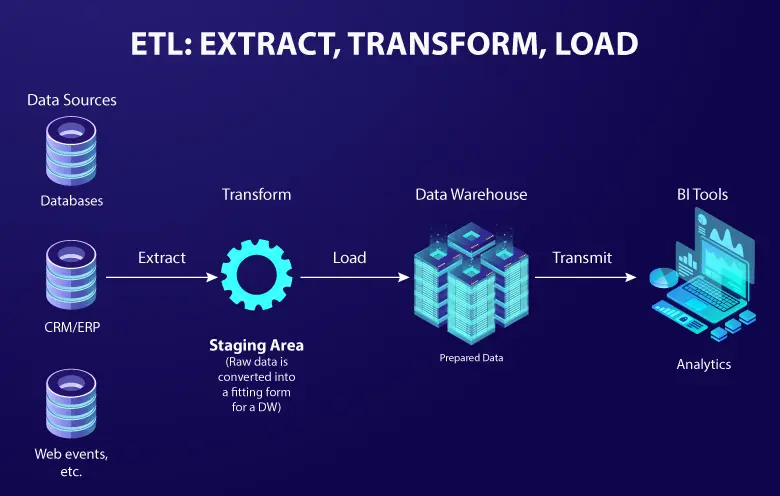In today’s dynamic business environment, data plays a crucial role in gaining valuable insights and making well-informed decisions. Among the many branches of big data analytics, diagnostic data analytics stands out as an exceptionally powerful technique.
By delving into historical data, this type of analytics helps organizations understand the root causes behind specific outcomes, events, or trends. Rather than simply describing what has occurred, this analysis seeks to answer the fundamental question: “Why did it happen?”
In this blog post, we will explore the nitty-gritty of diagnostic analytics and its immense potential for various business sectors. We will explore what, why and how of implementing diagnostic analytics solutions into your existing business model.
Let’s check out the hidden revenue opportunities this type of data analytics has to offer.
What is diagnostic analytics in big data and how does it work?
Diagnostic analytics is a type of data analysis that helps organizations understand the root causes of events or trends. It does this by systematically collecting, analyzing, and interpreting data, formulating hypotheses and conducting statistical tests.
The process of diagnostic analytics is divided into the following steps:
- Data collection: It begins with data collection from various sources, including historical records, transactional data, customer interactions and surveys. The quality and relevance of the data are essential for accurate analysis.
- Data cleaning and preparation: Next, the collected data is cleaned and prepared to ensure accuracy and consistency. Raw data often contains errors, missing values, and inconsistencies that need to be addressed before analysis can take place.
- Exploratory data analysis (EDA): Analysts then conduct exploratory data analysis (EDA) to understand the characteristics of the data. This step helps detect patterns and visualize relationships between variables. Through EDA, analysts generate hypotheses about potential factors contributing to observed outcomes.
- Hypothesis formulation: Based on their understanding of the data and domain knowledge, analysts formulate hypotheses. These educated guesses propose relationships between variables and potential causes of specific events.
- Statistical analysis: To test these hypotheses, the analyst employs a range of statistical techniques, including t-tests, chi-square tests, ANOVA (analysis of variance), and regression analysis. These methods find the statistical significance of relationships between variables.
- Causation vs. correlation: Understanding the difference between correlation and causation is crucial in the field of analytics. While diagnostic analytics can find correlations between variables, establishing causation often requires controlled experiments or additional evidence.
- Insights and interpretation: Once statistical analysis is conducted, analysts interpret the results to extract meaningful insights and explain how the variables are interconnected. They determine which variables have the most substantial impact on outcomes and explain how these variables are interconnected.
- Root cause identification: Furthermore, analysts delve beyond surface-level observations to uncover the root causes behind observed trends or events. Rigorous review and validation of the findings ensure that the analysis is reliable and the conclusions are supported by the data.
- Validation and robustness: The findings are rigorously reviewed and validated to ensure the analysis is reliable and the conclusions are supported by the data.
- Reporting and visualization: Now, insights can be effectively communicated through diagnostic data reporting, dashboards, and data visualizations that enhance stakeholders’ understanding and facilitate action based on the findings.
- Decision-making and action: Insights derived from diagnostic analytics techniques inform decision-making processes and strategy development. Organizations can implement changes, address issues, and optimize processes based on identified causes and recommendations.
Diagnostic analytics offers significant benefits for your organization to enhance data-driven decision-making capabilities, identify problems and optimize processes. You can leverage tools such as Tableau and Microsoft Power BI to create interactive visualizations and reports without relying on IT assistance. By understanding the root causes of events and trends, you can proactively prevent future occurrences or take advantage of beneficial circumstances.
Now that we have discussed what diagnostic analytics is and how it works, let’s learn what advantages it offers for improving your business.
What are the business benefits of diagnostic analytics?
- Enhanced decision making: With diagnostic decision support, you to make more informed decisions for your business by uncovering the underlying causes of issues and trends. This valuable information can be used to develop and implement effective solutions.
- Efficient problem identification and resolution: With diagnostic analytics, your business can swiftly identify and resolve problems. By understanding the root causes, your decision-makers can take preventative measures to mitigate future occurrences.
- Streamlined process optimization: Diagnostic analytics can help businesses optimize their processes by identifying areas where they can be improved. This information can be used to make changes that improve operational efficiency, reduce costs and improve customer satisfaction.
- Increased customer satisfaction: By helping your teams understand their customers better, diagnostic analytics also assists you in identifying ways to improve your customers’ satisfaction. In turn, this leads to increased customer loyalty and repeat business.
- Increased revenue generation: Also, this type of analytics helps your workforce identify opportunities to increase revenue. This can be done by understanding customer behavior, identifying trends, and developing new products and services.
- Reduced risks: Diagnostic analytics assist in identifying potential risks faced by the business so that proactive measures can be taken to minimize their impact.
How do different industries use diagnostic analytics?
| Industry | How They Use Diagnostic Analytics | Example |
| Retail | Analyze sales data and factors affecting purchases. | Investigating reasons for a drop in sales of a specific product and adjusting pricing or presentation. |
| Healthcare | Study patient records and treatment outcomes. | Understanding why a certain treatment plan isn’t delivering expected results and making necessary adjustments. |
| Manufacturing | Examine production processes and product quality. | Identifying production stages leading to defects and taking steps to enhance overall product quality. |
| Finance | Monitor transactions for unusual patterns. | Detecting irregular transactions that might indicate fraudulent activities and taking preventive measures. |
| Marketing | Analyze campaign performance and customer behaviors. | Understanding why a marketing campaign didn’t achieve desired outcomes and refining strategies for better engagement. |
| Supply Chain | Scrutinize supply chain operations and supplier performance. | Identifying bottlenecks causing delays in the supply chain and optimizing operations for smoother processes. |
| Telecommunications | Study customer complaints and network performance. | Pinpointing reasons for network disruptions and improving service reliability for customers. |
| Energy | Analyze energy consumption and environmental factors. | Understanding why energy consumption unexpectedly increased and implementing strategies for more efficient distribution. |
| Automotive | Study vehicle defects and performance metrics. | Identifying recurring defects in vehicles and making improvements to enhance vehicle quality and safety. |
| Agriculture | Analyze weather, crop yield, and soil quality data. | Understanding factors leading to lower crop yields and adjusting planting strategies for better results. |
Ultimately, diagnostic analytics is focused on meticulous investigation, data interpretation, and targeted improvements based on historical data insights across various industries.
How to incorporate diagnostic analytics into your business?
To effectively incorporate diagnostic analytics into your business, it is important to consider several key factors.
1. Data availability and quality
First and foremost, ensure that you have access to reliable and relevant data for analysis. The quality of data plays a critical role in drawing accurate conclusions. Invest in robust data collection and storage systems that can capture the necessary information accurately.
2. Analytical tools and expertise
Equipping your team with the right analytical tools and providing training to enhance their skills is also crucial. Statistical software, data visualization tools and programming languages like Python or R can greatly assist in conducting diagnostic analytics. Consider hiring or upskilling employees with expertise in data analysis and statistics.
3. Collaborative approach
Fostering collaboration among various departments and teams within your organization is a crucial element. This can be achieved through effective diagnostic data management, adopting a multidisciplinary approach, and leveraging insights from diverse functional areas such as finance, marketing, operations and more.
4. Continuous improvement
Embrace a culture of continuous improvement by regularly reviewing and refining your diagnostic data processing. Solicit feedback from stakeholders and actively seek opportunities to optimize your analysis methodologies and techniques.
5. Ethical considerations
Lastly, it is imperative to ensure that your diagnostic analytics practices align with ethical standards and data privacy regulations. Secure sensitive customer information and maintain transparency in how you collect, store and analyze data. By adhering to these considerations, you can successfully incorporate diagnostic data management services into your organization’s decision-making processes.
By integrating diagnostic analytics into your business operations, you can get valuable insights, proactively address operational challenges, and make well-informed decisions. It’s important to note that diagnostic analytics is just one part of a comprehensive data analytics solution.
When combined with descriptive, predictive, and prescriptive analytics, it forms an integrated approach that empowers businesses to flourish in today’s data-centric environment. You can make the most of diagnostic analytics solutions by harnessing the power of data to pave the way for growth and profitability.
Diagnostic analytics – Steering your organization towards success
Now that you are aware of diagnostic analytics and its capabilities that enable businesses to uncover the underlying causes of trends and anomalies, choose to implement it. Remember, by understanding the “why” behind data, your organization can unravel hidden revenue opportunities, prevent operational setbacks and enhance problem-solving capabilities. Incorporating diagnostic analytics into your business requires a solid understanding of key concepts, access to relevant data, analytical tools, and a collaborative approach. Partner with Softweb Solutions to drive your organization’s success in today’s data-driven world by implementing diagnostic analytics.



